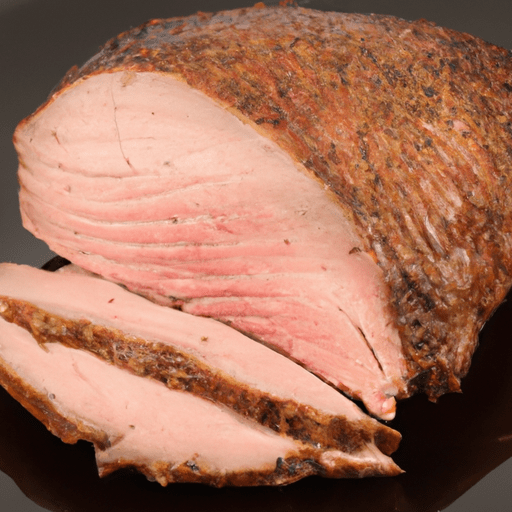The Perfect Roast Beef: A Culinary Delight
Roast beef is a classic dish that brings delight to the taste buds. Cooked to perfection, it is succulent, flavorful, and makes for a mouthwatering centerpiece on any table. Whether enjoyed on a lazy Sunday afternoon or served at a festive gathering, roast beef never fails to impress. In this blog post, we will explore the tantalizing taste, versatile uses, nutritional value, and fascinating history of roast beef.
The Taste Sensation
Roast beef is the epitome of indulgence, boasting rich, savory flavors that leave a lasting impression. The exterior is adorned with a beautifully caramelized crust, while the interior remains tender and juicy. When you take your first bite, the irresistible aroma fills the air, and the taste is nothing short of heavenly. Whether seasoned simply with salt and pepper or infused with herbs and spices, roast beef offers a symphony of flavors that leaves you craving for more.
Versatility in Cooking
Roast beef is a culinary chameleon. It can be prepared in various ways to suit different tastes and occasions. A classic roast beef is typically cooked in the oven. The meat is seared first to lock in the juices and then slow-roasted to achieve the perfect level of doneness. For those who enjoy a touch of smokiness, it can also be prepared on a grill or a smoker, adding an extra layer of complexity to the flavor profile.
Roast beef is not only delectable on its own but also shines when transformed into other dishes. Thinly sliced roast beef is ideal for creating mouthwatering sandwiches, such as the iconic roast beef and horseradish sandwich. It can also be used in stews, salads, stir-fries, and even pasta dishes, elevating the overall flavor and making every bite a memorable experience.
Nutritional Value
Apart from its tantalizing taste, roast beef also offers a range of nutritional benefits. This delectable protein source is packed with essential nutrients that promote overall health and well-being. It is an excellent source of high-quality protein, essential for muscle growth and repair. Roast beef also provides important vitamins and minerals, including iron, zinc, and B vitamins, which support energy production and a healthy immune system.
As with any food, moderation is key when considering the nutritional value. Lean cuts of roast beef, such as the eye of round or sirloin, offer a lower fat content, making them a healthier choice. Incorporating roast beef into a well-balanced diet can contribute to a nutrient-rich eating plan, providing a delicious way to meet your dietary needs.
A Glimpse into History
Roast beef has a long-standing history deeply rooted in culinary traditions. It has been a beloved dish across cultures for centuries. In medieval times, roast beef was considered a delicacy reserved for special occasions within the noble and royal circles. The invention of the closed oven in the 18th century revolutionized the cooking method, making it accessible to a wider audience and firmly establishing roast beef as a cherished culinary delight.
In Britain, roast beef holds a special place as a national dish. It became a symbol of patriotism during the 18th century, often referenced in literature and popular culture. The enduring association was even immortalized in the famous saying “Roast beef of old England,” which highlighted the nation’s love for this mouthwatering delicacy. Today, roast beef continues to be an integral part of British gastronomy and holds a special place in the hearts of food lovers worldwide.
Conclusion
Roast beef is a culinary masterpiece that promises a gastronomic experience like no other. With its tantalizing taste, versatility in cooking, and nutritious qualities, it has rightfully earned its place as a beloved dish across cultures and generations. So, next time you find yourself in the kitchen, consider preparing a delectable roast beef, and indulge in the rich flavors and historical significance it represents.
Interesting Facts About Roast Beef:
Origin: Roast beef is a dish that is traditionally associated with the cuisine of medieval England. It became particularly popular during the reign of King Henry VII in the late 15th century.
Preparation: Roast beef refers to a style of cooking beef where it is roasted in an oven or over an open flame. The meat is typically cooked at a high temperature to create a browned exterior while maintaining a tender and juicy interior.
Common Uses: Roast beef is often served as a centerpiece in a traditional Sunday lunch or Christmas dinner. It is also commonly used in sandwiches, particularly the classic “roast beef and horseradish” combination.
Nutritional Benefits: Roast beef is a good source of high-quality protein, essential vitamins, and minerals. It is particularly rich in iron, zinc, and vitamin B12. However, it’s important to note that the nutritional profile can vary depending on the cut of beef and cooking methods used.
Unique Properties: Roast beef is known for its savory flavor and tender texture. The Maillard reaction that occurs during the cooking process gives roasted beef its characteristic browned and flavorful crust.
Historical Significance: In England, roast beef has long been associated with national identity. It was famously satirized in a 1731 political cartoon by William Hogarth as a symbol of the English way of life. The cartoon emphasized the English love for roast beef and depicted it as a contrast to French cuisine.
These facts give an overview of roast beef, including its origin, uses, health benefits, unique properties, and historical significance. Whether enjoyed as a classic Sunday roast or a tasty sandwich filling, roast beef has become a beloved dish in many cultures.




Use the share button below if you liked it.
It makes me smile, when I see it.